![]()
Baccarat Paperweights for Sale
![]()
Baccarat Paperweights for Sale
New research of the Baccarat archives has identified the actual makers during the Dupont period as Joseph Boyé (1877-1948) and Louis Idoux (1882-1941). Boyé is recorded as the maker of millefiori canes and millefiori paperweights during this period (1920-1934). Very little is known about Mr. Boyé, but there is enough similarity in the millefiori canes to suggest that he had access to the original molds or some of the original millefiori canes from the classic period. He later trained another glassworker, Georges Brocard, to make open concentric paperweights in 1946. Armed with this knowledge, Brocard was influential in the revival of paperweight making at Baccarat in the 1950s. Louis Idoux is recorded as making the Baccarat pansy paperweights during the 1920-1934 period.
In 1952, Paul Jokelson approached Baccarat with the idea of making sulphide paperweights again. In 1953 Baccarat resumed paperweight production with a series of sulphide paperweights the first of which were the unsuccessful Eisenhower sulphide followed by the Queen Elizabeth coronation sulphide. Millefiori paperweight production was resumed in 1957 and lampwork paperweights were re-introduced in the early 1970s. Baccarat stopped making this type of fine glass paperweights in 2002.
You can read more about the Baccarat paperweights in the new book Baccarat Paperweights - two centuries of beauty by Paul Dunlop or one of the older books on paperweights in general, such as The Encyclopedia of Glass Paperweights by Paul Hollister or World Paperweights by Robert Hall.
You can read more about the Baccarat paperweights in the books:
| 4860 | Rare Magnum Baccarat 2000 Rendez-vous des
Libellules Dragonflies Limited Edition Faceted Paperweight with
Box. dated 2000. This magnificent very large
faceted paperweight features five colored dragonflies flying above
the ground. The ground has a translucent green layer above an
opaque white layer. The title "Rendez-vous des Libellules"
translates as "Meeting of the Dragonflies". Baccarat made this
design in 2000 in a limited edition of 75 paperweights. It is
signed in the design with a complex "B2000" signature / date cane
and is also signed on the base with an acid etched Baccarat mark
along with the year (2000) and edition number (54 / 75). There
is also a Baccarat etched signature on the side next to the base and
a Baccarat red paper label on the base. The paperweight is
faceted with a barrel faceting having a top facet and 75 side cuts
in five rows. This paperweight comes with its original rigid
Baccarat box. One of the best of the Baccarat
paperweights. Large and showy with great color. Baccarat was founded in 1776 in Alsace-Lorraine with the name of Verrerie de Sainte Anne. The original location was near the town of Baccarat. Today the firm is known as Compagnie des Cristalleries de Baccarat. In 1952, Paul Jokelson approached Baccarat with the idea of making sulphide paperweights again. In 1953 Baccarat resumed paperweight production with a series of sulphide paperweights the first of which were the unsuccessful Eisenhower sulphide followed by the Queen Elizabeth coronation sulphide. Millefiori paperweight production was resumed in 1957 and lampwork paperweights were re-introduced in the early 1970s. Baccarat stopped making this type of fine glass paperweights in 2002. You can read more about the Baccarat paperweights in his book Baccarat Paperweights - two centuries of beauty by Paul Dunlop or one of the older books on paperweights in general, such as The Encyclopedia of Glass Paperweights by Paul Hollister or World Paperweights by Robert Hall. Very large size: 3 5/16" diameter by just under 2
1/16" high. The base is polished flat. The paperweight
is faceted with a barrel faceting having a top facet and 75 side
cuts in five rows. The box is 5 3/16" by 5 3/16" by 4 1/16"
high. For extra pictures, click on the picture at the right and the following links: Large pictureSOLD. US Sales only, no international shipping. Delivery will require a signature. Click on the picture to see a larger image. |
Click
on the picture to see a larger image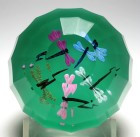 |
| 5401 | Large Baccarat 1977 Spaced Millefiori on
Lace Paperweight. dated 1977. This wonderful
spaced millefiori paperweight from Baccarat contains an arrangement
of 19 millefiori canes on a lace or upset muslin ground. The
canes are intricate and very colorful. See the close-up
picture for more detail. It is signed with a Baccarat "B1977"
signature / date cane in the design. And the base is signed
with an etched Baccarat logo, the engraved edition number (52), and
the engraved year (1977). It comes with its original
(distressed) box and certificate. A large colorful
example.
This design was produced in 1977. It is not listed as a limited edition, but the individual paperweights were numbered sequentially. This is number 52 in that series. Paul Dunlop states on page 178 of his book Baccarat Paperweights two centuries of beauty that this style was made in numerous years as a numbered edition paperweight. Note on white glare: Please ignore the white areas, they are glare from the lights. Baccarat was founded in 1776 in Alsace-Lorraine with the name of Verrerie de Sainte Anne. The original location was near the town of Baccarat. Today the firm is known as Compagnie des Cristalleries de Baccarat. In 1952, Paul Jokelson approached Baccarat with the idea of making sulphide paperweights again. In 1953 Baccarat resumed paperweight production with a series of sulphide paperweights the first of which were the unsuccessful Eisenhower sulphide followed by the Queen Elizabeth coronation sulphide. Millefiori paperweight production was resumed in 1957 and lampwork paperweights were re-introduced in the early 1970s. Baccarat stopped making this type of fine glass paperweights in 2002. You can read more about the Baccarat paperweights in his book Baccarat Paperweights - two centuries of beauty by Paul Dunlop or one of the older books on paperweights in general, such as The Encyclopedia of Glass Paperweights by Paul Hollister or World Paperweights by Robert Hall. Large size: 3 1/16" diameter by just over 2 1/4"
high. The base is polished flat. For extra pictures, click on the picture at the right and the following links: Large pictureSOLD. Click on the picture to see a larger image. |
Click
on the picture to see a larger image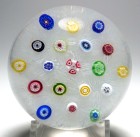 |
| 3506 | Antique Baccarat Miniature Single Clematis
with Millefiori Garland Paperweight. circa
1845-1860. Antique Baccarat miniature red/orange single
clematis with six ribbed petals, five leaves, and a stem. The
center of the flower is a complex millefiori cane with two rings of
white star shaped canes arranged around a red bulls-eye cane.
The clematis is surrounded by an outer garland of alternating ten
white and ten blue and white complex millefiori canes. The
white canes in the garland match the cane at the center of the
clematis flower. The blue and white canes have a ring of
arrowhead canes around a Baccarat star cane. The design is
placed over a clear ground and finished with a Baccarat star cut on
the base. The paperweight is unsigned but I guarantee that
this is a genuine Baccarat millefiori paperweight from the classic
period 1845-1860. A unique addition to any collection of
miniature paperweights. Great color. Note: The flower is noticeably off-center in this paperweight. Note on white glare: Please ignore the white areas, they are glare from the lights. According to Paul Dunlop in Baccarat Paperweights: two centuries of beauty, the single clematis is much rarer than the double clematis. Miniature Size: 1 15/16" diameter by just under 1
7/16" high. The bottom is ground slightly concave and is
finished with a Baccarat star. For extra pictures, click on the picture at the right and the following links: Large picture of the paperweight$1,750 postage paid in the US. US sales only for this paperweight. Delivery will require a signature. Click on the picture to see a larger image. Baccarat was founded in 1776 in Alsace-Lorraine with the name of Verrerie de Sainte Anne. The original location was near the town of Baccarat. Today the firm is known as Compagnie des Cristalleries de Baccarat. Most collectors refer to three periods of Baccarat paperweight production.
Baccarat continued to make paperweights after the classic period (1845-1860), but little is known about the extent of the product line or who made the paperweights. It is known that by 1910, the offering in the catalog had dwindled to pansy paperweights, simple open concentric paperweights, and rock paperweights. Popular lore attributes 1920-1934 Baccarat paperweights to a Mr. Dupont, who supposedly was the last worker at Baccarat to know the secrets of paperweight making. These paperweights were sold at a Baccarat retail shop in Paris. No collector or scholar ever met Mr. Dupont although at least one visited the Baccarat factory and asked to meet with him. The weights stopped appearing in the shop in 1934. New research of the Baccarat archives has identified the actual maker as Joseph Boyé (1877-1948). He is recorded as the maker of millefiori canes and millefiori paperweights during this period (1920-1934). Very little is known about Mr. Boyé, but there is enough similarity in the millefiori canes to suggest that he had access to the original molds or some of the original millefiori canes from the classic period. He later trained another glassworker, Georges Brocard, to make open concentric paperweights in 1946. Armed with this knowledge, Brocard was influential in the revival of paperweight making at Baccarat in the 1950s. Another glassworker, Louis Idoux (1882-1941), is recorded as making the Baccarat pansy paperweights during the 1920-1934 period. You can read more about the Baccarat paperweights in the new book Baccarat Paperweights - two centuries of beauty by Paul Dunlop or one of the older books on paperweights in general, such as The Encyclopedia of Glass Paperweights by Paul Hollister or World Paperweights by Robert Hall. |
Click
on the picture to see a larger image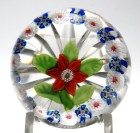 |
| 3547 | Baccarat 1987 Special Edition Double
Trefoil Millefiori Paperweight. dated 1987.
This modern millefiori paperweight features a double trefoil design
with a concentric pattern in the center. It has two interlaced
three lobe garlands of amber and burgundy. The concentric
design has green and amber circles. The design is placed on a
pale yellow lace ground. This was one of the special
paperweights featured in Baccarat's 1987 annual brochure. It
was made in this color arrangement only in 1987. It is signed
with a Baccarat's complex "B 1987" signature / date cane in the
design. This paperweight is also signed on the base with an
acid etched Baccarat mark along with the engraved year (1987) and
edition number (64). A fantastic paperweight. Note: After extensive research in the Baccarat archives, Paul Dunlop concluded that from 1986 to 1989, Baccarat made special editions of four designs using a different color scheme each year. For example, the double trefoil was made in each of the four years, but with a different color scheme each year. These designs were featured in the annual brochure for each year and were numbered sequentially. Although the edition size was not known he estimated that about 200 of each design were made. Large Size: Just under 3 3/16" diameter by 2 3/8"
high. The base is polished flat. For extra pictures, click on the picture at the right and the following links: Large picture$465 postage paid in the US. Added 4/22/2022. For more information about Baccarat paperweights, see my Baccarat Paperweights Web Page Click on the picture to see a larger image. Baccarat was founded in 1776 in Alsace-Lorraine with the name of Verrerie de Sainte Anne. The original location was near the town of Baccarat. Today the firm is known as Compagnie des Cristalleries de Baccarat. Most collectors refer to three periods of Baccarat paperweight production.
In 1952, Paul Jokelson approached Baccarat with the idea of making sulphide paperweights again. In 1953 Baccarat resumed paperweight production with a series of sulphide paperweights the first of which were the unsuccessful Eisenhower sulphide followed by the Queen Elizabeth coronation sulphide. Millefiori paperweight production was resumed in 1957 and lampwork paperweights were re-introduced in the early 1970s. Baccarat stopped making this type of fine glass paperweights in 2002. You can read more about the Baccarat paperweights in the new book Baccarat Paperweights - two centuries of beauty by Paul Dunlop or one of the older books on paperweights in general, such as The Encyclopedia of Glass Paperweights by Paul Hollister or World Paperweights by Robert Hall. |
Click
on the picture to see a larger image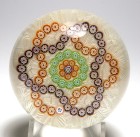 |
| 2643 | Large Faceted Baccarat Limited Edition
Fruit Basket Paperweight. dated 1976.
Classical design with a lampwork basket of fruit set over an opaque
white milk glass ground. The basket is filled with luscious
strawberries with leaves attached. It is signed with a
Baccarat signature cane "B 1976" and also signed again on the base
with the Baccarat logo. The paperweight is faceted with a
large concave top facet and six smaller concave side facets.
Perfect execution.
This design was produced only in 1976 in a limited edition of 300 paperweights. This is number 57 in that series. There is a signature cane "B 1976" shown in the pictures. The base has the acid etched Baccarat logo plus it is engraved with the year (1976), the edition number (57) and the size of the series (300). It is unusual to find a Baccarat paperweight with a white opaque ground as they produced very few designs with this choice of ground. It works perfectly as a contrast to the delicate fruit basket. Baccarat originally suggested a retail price of $3,542 for this paperweight, but my price is much lower. Large size: 3 1/16" diameter by 1 7/8" high. The
base is polished flat. Faceted with a large top facet and
six side facets. All the facets are concave. For extra pictures, click on the picture at the right and the following links: Large picture
Click on the picture to see a larger image. Baccarat was founded in 1776 in Alsace-Lorraine with the name of Verrerie de Sainte Anne. The original location was near the town of Baccarat. Today the firm is known as Compagnie des Cristalleries de Baccarat. Most collectors refer to three periods of Baccarat paperweight production.
In 1952, Paul Jokelson approached Baccarat with the idea of making sulphide paperweights again. In 1953 Baccarat resumed paperweight production with a series of sulphide paperweights the first of which were the unsuccessful Eisenhower sulphide followed by the Queen Elizabeth coronation sulphide. Millefiori paperweight production was resumed in 1957 and lampwork paperweights were re-introduced in the early 1970s. Baccarat stopped making this type of fine glass paperweights in 2002. You can read more about the Baccarat paperweights in the new book Baccarat Paperweights - two centuries of beauty by Paul Dunlop or one of the older books on paperweights in general, such as The Encyclopedia of Glass Paperweights by Paul Hollister or World Paperweights by Robert Hall. |
Click
on the picture to see a larger image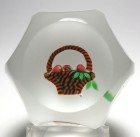 |
| 6072 | Modern Baccarat Macédoine Millefiori
Paperweight. circa 1957-1970s. This
paperweight is made up of multi-colored striped millefiori segments
arranged at (mostly) right angles. This is a contemporary
paperweight made for only a short time. It is acid etched with
the Baccarat signature on the base. This is a great example of
a unique Baccarat design.
The Macédoine is a uniquely Baccarat style in which the short sections of latticinio (twists, filigree, lace) are arranged in a quilt-like pattern with many of the sections at right angles to each other. This pattern was originally made during the classic period of French paperweights (1845-1860). The modern version was produced in the 1950s - 1970s and is similar to yet different from the antique version. Baccarat was founded in 1776 in Alsace-Lorraine with the name of Verrerie de Sainte Anne. The original location was near the town of Baccarat. Today the firm is known as Compagnie des Cristalleries de Baccarat. In 1952, Paul Jokelson approached Baccarat with the idea of making sulphide paperweights again. In 1953 Baccarat resumed paperweight production with a series of sulphide paperweights the first of which were the unsuccessful Eisenhower sulphide followed by the Queen Elizabeth coronation sulphide. Millefiori paperweight production was resumed in 1957 and lampwork paperweights were re-introduced in the early 1970s. Baccarat stopped making this type of fine glass paperweights in 2002. You can read more about the Baccarat paperweights in his book Baccarat Paperweights - two centuries of beauty by Paul Dunlop or one of the older books on paperweights in general, such as The Encyclopedia of Glass Paperweights by Paul Hollister or World Paperweights by Robert Hall.
Large size: 2 7/8" diameter by just over 2 1/8"
high. The base is polished flat. For extra pictures, click on the picture at the right and the following links: Large picture$245 postage paid in the US. Click on the picture to see a larger image. |
Click
on the picture to see a larger image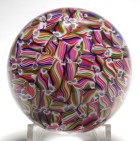 |
| 3065 | Antique Baccarat Dupont Period
Miniature Concentric Millefiori Paperweight. circa
1900-1932. This is a very nice example of a Dupont period
paperweight from Baccarat. The middle (red) ring has great
Baccarat star and arrow canes. The inner ring has nice white
stardust canes with blue whorls in the center. There is a
slight chance that this is from the classic period, but the outer
ring is less distinct which is why I think it is Dupont. The
design is off center. A very nice example. Miniature Size: Just under 2 1/16” diameter by 1
1/2” high. Base is slightly concave. Baccarat was founded in 1776 in Alsace-Lorraine with the name of Verrerie de Sainte Anne. The original location was near the town of Baccarat. Today the firm is known as Compagnie des Cristalleries de Baccarat. Most collectors refer to three periods of Baccarat paperweight production.
For extra pictures, click on the picture at the right and the following links: Large picture of the paperweight$295 postage paid in the US. Click on the picture to see a larger image. |
Click
on the picture to see a larger image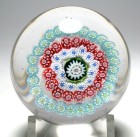 |
| 2530 | Magnum Baccarat Eight Row 1988 Close
Concentric Millefiori Paperweight. dated
1988. This magnificent close concentric millefiori paperweight
has eight rings or rows with the outer ring pulled down to the
center of the base to form a stave basket. Baccarat made this
design in 1988 and it has an edition number of 60, but no edition
size. The paperweight is signed in the design with Baccarat's
complex signature / date cane "B 1988" in the next to the last
ring. It also has an acid etched Baccarat mark on the base
along with the year (1988) and edition number (60). One of the
best of the Baccarat concentric paperweights. Large and showy
with great color. Note on edition size: According to Paul Dunlop, this design is not a limited edition and the number made is unknown. This design is shown on page 211 of Dunlop's book on Baccarat and is one of four numbered edition designs. In 1988 all four numbered editions featured a green color. Baccarat was founded in 1776 in Alsace-Lorraine with the name of Verrerie de Sainte Anne. The original location was near the town of Baccarat. Today the firm is known as Compagnie des Cristalleries de Baccarat. In 1952, Paul Jokelson approached Baccarat with the idea of making sulphide paperweights again. In 1953 Baccarat resumed paperweight production with a series of sulphide paperweights the first of which were the unsuccessful Eisenhower sulphide followed by the Queen Elizabeth coronation sulphide. Millefiori paperweight production was resumed in 1957 and lampwork paperweights were re-introduced in the early 1970s. Baccarat stopped making this type of fine glass paperweights in 2002. You can read more about the Baccarat paperweights in his book Baccarat Paperweights - two centuries of beauty by Paul Dunlop or one of the older books on paperweights in general, such as The Encyclopedia of Glass Paperweights by Paul Hollister or World Paperweights by Robert Hall. Large size: Just under 3 1/4" diameter by just
under 2 7/16" high. The base is polished
flat. For extra pictures, click on the picture at the right and the following links: Large picture$495 postage paid in the US. Click on the picture to see a larger image. |
Click on the picture
to see a larger image 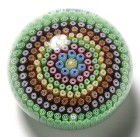 |
| 6016 | Magnum Antique Baccarat Macédoine
(Scramble) Millefiori Paperweight with Finger
Facets. circa 1845-1860. This
very large antique Baccarat paperweight is made up of multi-colored
striped millefiori segments arranged at (mostly) right angles.
It is finished at the base with 20 finger facets. This is a
antique paperweight made during the classic period of paperweight
making (1845-1860). A great example of this unique style of
antique Baccarat paperweight. Great color. The condition
is fair to good. Note on condition: The condition of this paperweight is fair to good. It displays well but has numerous scratches on the dome and one 3/16" chip on the side. It also has wear on some of the finger facets. Note on pictures: Some of the side pictures have dark vertical areas. These are reflections caused by the finger facets and the dark sides of my photo area. They are not a flaw in the glass. The Macédoine is a uniquely Baccarat style in which the short
sections of latticinio (twists, filigree, lace) are arranged in a
quilt-like pattern with many of the sections at right angles to
each other. Usually there are no millefiori
present. This pattern was originally made during the
classic period of French paperweights (1845-1860). A modern
version was produced in the 1960s and is similar to but different
from the antique version.
Very large size: Just over 3 1/8" diameter by 2
5/16" high. The bottom is ground concave. It is
finished with 20 finger facets extending up from the base. For extra pictures, click on the picture at the right and the following links: Large pictureSOLD. Click on the picture to see a larger image. |
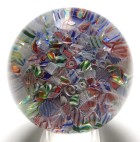 |
|
4644
|
Unique Baccarat 1964 JFK Sulphide Double
Overlay Paperweight. dated 1963, issued 1964. This
modern Baccarat sulphide paperweight features a large three
dimensional figure of President John F. Kennedy. Even
though it is dated 1963, I believe it wasn't issued until 1964 after
Kennedy was assassinated. The sulphide figure was designed by
Albert David. It has a cobalt blue and white overlay with a
red base. The paperweight is faceted with one large top facet
and five side facets. The overlay has an unusual cutting with
half-circle notches between each facet. Only 201 copies were
made with this color combination, but the cutting may be
unique. It is signed on the edge of the sulphide "A. DAVID 63"
and has an acid etched Baccarat logo / mark on the base. An
extra nice example. Paul Dunlop provides a detailed study of the variations on this paperweight. This paperweight was made in several formats, including 308 overlays and 3,572 non-overlays. Of the overlays, 201 were like the example shown here with a red uncut base and a blue and white overlay. However not all of the 201 will have the same cutting on the double overlay as the glass workers at Baccarat were given some artistic freedom to vary the cutting. 35 more were finished with a star cut on the base. And 72 were made with a blue base and a red and white overlay. There were nine different formats for the 3,572 non-overlay versions. An additional 314 non-overlay weights with an amethyst base were issued in a memorial edition. Sulphides are cast objects (animals, flowers, people) made of a ceramic material that has properties similar to the surrounding glass. They are normally white, but are also sometimes colored or even painted. The objects are cast in a mold that copied or made directly from a medallion, coin or sculpture. The finest French sulphides are cast in a mold made by a skilled artist. Sometimes a sulphide will have a silvery appearance due to a thin layer of trapped bubbles between the glass and the sulphide itself. Baccarat was founded in 1776 in Alsace-Lorraine with the name of Verrerie de Sainte Anne. The original location was near the town of Baccarat. Today the firm is known as Compagnie des Cristalleries de Baccarat. In 1952, Paul Jokelson approached Baccarat with the idea of making sulphide paperweights again. In 1953 Baccarat resumed paperweight production with a series of sulphide paperweights the first of which were the unsuccessful Eisenhower sulphide followed by the Queen Elizabeth coronation sulphide. Millefiori paperweight production was resumed in 1957 and lampwork paperweights were re-introduced in the early 1970s. Baccarat stopped making this type of fine glass paperweights in 2002. You can read more about the Baccarat paperweights in his book Baccarat Paperweights - two centuries of beauty by Paul Dunlop or one of the older books on paperweights in general, such as The Encyclopedia of Glass Paperweights by Paul Hollister or World Paperweights by Robert Hall. Albert David (1896 - 1970) was a French sculptor and ceramist who studied under Jean Boucher at the École des Beaux-Arts in Paris. David exhibited in Paris at the Salon of the Société des Artistes Français, Salon d'Automne and the Salon des Artistes Décorateurs. He received an honorable mention in 1921, a gold medal at the 1937 Exposition Universelle and a third-class medal in 1938. His work was entered in the Art competitions at the 1924 Summer Olympics, but he did not win a medal. In 1938, he was was made a Chevalier of the Legion of Honor. He was particularly known for his flat reliefs and war memorials and also his pottery. In addition, he also designed plaques and medals. David served as an official sculptor for the Monnaie de Paris (Paris Mint), a government-owned institution responsible for producing France's coins. During the 1960s he designed sulphides for Baccarat, some of which were produced after his death in 1970. Large Size: 3 1/8" diameter by just over 2 1/8"
high. The base is polished flat is faceted with one large
top facet and five side facets. For extra pictures, click on the picture at the right and the following links: Large picture$235 postage paid in the US. Click on the picture to see a larger image. |
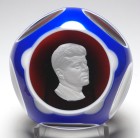 |
| 5483 | Baccarat 1971 Gridel Series Magnum
Millefiori Rooster Limited Edition Paperweight. dated
1971. This modern millefiori paperweight features a large
central black Gridel rooster silhouette facing left on a white
background. The rooster cane is set in the center of a
concentric design with four rings of millefiori canes, including a
ring of all 18 Gridel canes. The design is set on a lace
ground. Baccarat's complex signature / date cane "B 1971" is
in the third ring at 3 o'clock. The rooster appears twice,
once in the center and a smaller one facing right at 2
o'clock. This design was released in 1971 in a limited edition
of 1,200 pieces. This is number 519 in that edition.
This paperweight is also signed on the base with two acid etched
Baccarat marks along with the year (1971) and edition number
(519). The year is hard to read on the base as it was engraved
on top of one of the Baccarat marks. I show several pictures
of this signature taken from different angles. An extra large
example. In 1846 Baccarat introduced the popular Gridel figures in their closepack millefiori paperweights. It was named after Emil Gridel, the nephew of Jean-Baptiste Toussaint the general manager of Baccarat. Toussaint saw Gridel making paper cutouts of animals and saw an opportunity to incorporate these silhouettes in millefiori paperweights. From 1971 to 1979 Baccarat issued a modern Gridel series of millefiori paperweights based on eighteen Gridel figures. Each paperweight has a large Gridel figure in the center with smaller versions of the other figures included in the design. There are variations in orientation and color as well as the types of canes in each design and it is possible to amass a very large collection covering just this series. Very large size: Just over 3 3/8" diameter by 2
1/16" high. The base is polished
flat. The profile is slightly flat. For extra pictures, click on the picture at the right and the following links: Large picture$395 postage paid in the US. Click on the picture to see a larger image. |
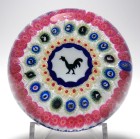 |
| 4245 | Antique Baccarat Miniature Spaced
Concentric Millefiori Paperweight with Four Gridel Canes on a Lace
Ground. circa 1847-1860. Antique Baccarat spaced
concentric millefiori paperweight with seven complex millefiori
canes, including four Gridel figures, the butterfly, dog, goat, and
deer. There are also two arrowhead canes and a multicolored
complex cane. Six canes are arranged in a circle around a
great center cane. The design is placed on a white lace ground
with bits of colored filigree. This perfectly balanced
miniature paperweight will be a wonderful to any collection antique
paperweights. According to Paul Dunlop in the Dictionary of Glass Paperweights, the first Gridel cane to appear was the lovebirds cane, which appeared in some 1846 paperweights. The others appeared in 1847 or later. Baccarat was founded in 1776 in Alsace-Lorraine with the name of Verrerie de Sainte Anne. The original location was near the town of Baccarat. Today the firm is known as Compagnie des Cristalleries de Baccarat. Most collectors refer to three periods of Baccarat paperweight production.
Baccarat continued to make paperweights after the classic period (1845-1860), but little is known about the extent of the product line or who made the paperweights. It is known that by 1910, the offering in the catalog had dwindled to pansy paperweights, simple open concentric paperweights, and rock paperweights. Popular lore attributes 1920-1934 Baccarat paperweights to a Mr. Dupont, who supposedly was the last worker at Baccarat to know the secrets of paperweight making. These paperweights were sold at a Baccarat retail shop in Paris. No collector or scholar ever met Mr. Dupont although at least one visited the Baccarat factory and asked to meet with him. The weights stopped appearing in the shop in 1934. New research of the Baccarat archives has identified the actual maker as Joseph Boyé (1877-1948). He is recorded as the maker of millefiori canes and millefiori paperweights during this period (1920-1934). Very little is known about Mr. Boyé, but there is enough similarity in the millefiori canes to suggest that he had access to the original molds or some of the original millefiori canes from the classic period. He later trained another glassworker, Georges Brocard, to make open concentric paperweights in 1946. Armed with this knowledge, Brocard was influential in the revival of paperweight making at Baccarat in the 1950s. Another glassworker, Louis Idoux (1882-1941), is recorded as making the Baccarat pansy paperweights during the 1920-1934 period. You can read more about the Baccarat paperweights in the book Baccarat Paperweights - two centuries of beauty by Paul Dunlop or one of the older books on paperweights in general, such as The Encyclopedia of Glass Paperweights by Paul Hollister or World Paperweights by Robert Hall. Miniature Size: Just under 2" diameter by 1 3/8"
high. The bottom is ground concave.. For extra pictures, click on the picture at the right and the following links: Large picture of the paperweightSOLD. US sales only for this paperweight. Delivery will require a signature. Click on the picture to see a larger image. |
Click
on the picture to see a larger image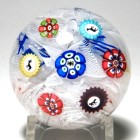 |
| 2958 | Antique Baccarat
Roundels or Circlets Millefiori Paperweight. circa
1845-1860. Antique Baccarat millefiori paperweight with a red,
white, and blue garland pattern consisting of seven circles of
millefiori canes, each with a single complex cane in the
center. Six of the roundels are arranged in a a circle around
the center roundel. The design is placed over a clear
ground. The paperweight is unsigned but has several unique
Baccarat canes and I guarantee that this is a genuine Baccarat
millefiori paperweight from the classic period 1845-1860. A
desirable addition to any collection of antique paperweights.
Great color. Baccarat was founded in 1776 in Alsace-Lorraine with the name of Verrerie de Sainte Anne. The original location was near the town of Baccarat. Today the firm is known as Compagnie des Cristalleries de Baccarat. Most collectors refer to three periods of Baccarat paperweight production.
In 1952, Paul Jokelson approached Baccarat
with the idea of making sulphide paperweights again. In
1953 Baccarat resumed paperweight production with a series of
sulphide paperweights the first of which were the unsuccessful
Eisenhower sulphide followed by the Queen Elizabeth coronation
sulphide. Millefiori paperweight production was resumed in
1957 and lampwork paperweights were re-introduced in the early
1970s. Baccarat stopped making this type of fine glass
paperweights in 2002. You can read more about the Baccarat
paperweights in the book Baccarat
Paperweights - two centuries of beauty by
Paul Dunlop or one of the older books on paperweights in
general, such as The
Encyclopedia of Glass Paperweights by Paul Hollister
or World Paperweights by Robert
Hall. Size: 2 5/8" diameter by 1 3/4" high. The
bottom is ground concave. For extra pictures, click on the picture at the right and the following links: Large pictureSOLD. Click on the picture to see a larger image. |
Click
on the picture to see a larger image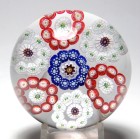 |
| 5211 | Baccarat 1971 Millefiori Mushroom
Turquoise Double Overlay Paperweight. dated 1971.
This
modern millefiori paperweight features a wonderful six row
concentric millefiori design with design pulled down to the base
to form a slender stem, completing the mushroom form. The
outer ring alternates between blue and yellow canes to create an
interesting pattern when viewed from the base. The design is
placed over clear crystal and finished with a turquoise and white
double overlay. It is signed with a Baccarat complex "B1971"
signature / date cane in the fourth ring from the center.
This paperweight is also signed twice on the base with an acid
etched Baccarat mark along with the engraved year (1971) and
edition number (153). The overlay is faceted with one large
top facet and five side facets. A fantastic paperweight. A mushroom paperweight is one that contains an upright, mushroom shaped tuft of millefiori canes. Below the tuft at the top, the canes are pulled down to form a stem. Typically the top is either a closepacked design or a close concentric design. Sometimes, especially with antique paperweights, a torsade is added surrounding the stem of the mushroom. Millefiori mushroom paperweights like this are among the most difficult paperweights to make. Add the double overlay and you have an extremely challenging and desirable paperweight. Note on limited editions: After extensive research in the Baccarat archives, Paul Dunlop concluded that popular designs like this were numbered editions, but not limited editions. Baccarat made them in more than one year as sales demanded and numbered the production sequentially. I am not entirely in agreement, but I am content to adopt Dunlop's terminology and refer to this as a numbered 1971 edition. I believe Baccarat intended to limit production of challenging designs like this double overlay mushroom. The records, if any, remain to be found. Baccarat was founded in 1776 in Alsace-Lorraine with the name of Verrerie de Sainte Anne. The original location was near the town of Baccarat. Today the firm is known as Compagnie des Cristalleries de Baccarat. In 1952, Paul Jokelson approached Baccarat with the idea of making sulphide paperweights again. In 1953 Baccarat resumed paperweight production with a series of sulphide paperweights the first of which were the unsuccessful Eisenhower sulphide followed by the Queen Elizabeth coronation sulphide. Millefiori paperweight production was resumed in 1957 and lampwork paperweights were re-introduced in the early 1970s. Baccarat stopped making this type of fine glass paperweights in 2002. You can read more about the Baccarat paperweights in his book Baccarat Paperweights - two centuries of beauty by Paul Dunlop or one of the older books on paperweights in general, such as The Encyclopedia of Glass Paperweights by Paul Hollister or World Paperweights by Robert Hall. Large size: 2 15/16" diameter by just over 2"
high. The base is polished
flat. The paperweight is faceted with one large top
facet and a five side facets. For extra pictures, click on the picture at the right and the following links: Large pictureSOLD. Click on the picture to see a larger image. |
Click
on the picture to see a larger image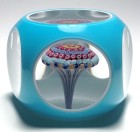 |
| 5299 | Baccarat Modern Four Row Open Concentric
Millefiori Paperweight. Circa 1958 - 1965.
This paperweight has an open concentric design with four rows of
pastel colored millefiori around a central complex center
cane. It is signed with an etched Baccarat logo on the
base. The paperweight contains examples of early Baccarat
complex millefiori and dates from the first years of Baccarat modern
millefiori production. Baccarat was founded in 1776 in Alsace-Lorraine with the name of Verrerie de Sainte Anne. The original location was near the town of Baccarat. Today the firm is known as Compagnie des Cristalleries de Baccarat. Most collectors refer to three periods of Baccarat paperweight production.
Baccarat started making modern millefiori paperweights in 1957. According to Paul Dunlop ( Baccarat Paperweights: Two Centuries of Beauty ), Baccarat started making the modern spaced millefiori paperweights on muslin or lace in 1958 and continued making undated examples until the limited editions were started in 1970. The exception is 1964 when special versions were produced for Baccarat's 200th anniversary. Medium Size: Just over 2 1/2” diameter by 1 3/4”
high. The base is polished flat. For extra pictures, click on the picture at the right and the following links: Large pictureSOLD. Click on the picture to see a larger image. |
Click
on the picture to see a larger image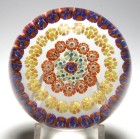 |
| 4199 | Large Antique Baccarat Double Trefoil
Millefiori Paperweight. circa 1845-1860. Colorful
antique Baccarat double trefoil millefiori paperweight with a clear
ground. The trefoils are constructed with blue and white
canes. In the center is a circle of green and white canes with
a orange cane in the very center. I believe this is from the
classic period of paperweight production (1845-1860), but it may
date from a later period. An interesting example. Note on colors: Please ignore the brown colors in some of the pictures. They are reflections from something in my work area. The glass is clear. Baccarat was founded in 1776 in Alsace-Lorraine with the name of Verrerie de Sainte Anne. The original location was near the town of Baccarat. Today the firm is known as Compagnie des Cristalleries de Baccarat. Most collectors refer to three periods of Baccarat paperweight production.
Large size: Just over 2 3/4" diameter by 1 7/8"
high. The bottom is polished concave. Unusually
high dome with the original Baccarat profile. For extra pictures, click on the picture at the right and the following links: Large pictureSOLD. Click on the picture to see a larger image. |
Click
on the picture to see a larger image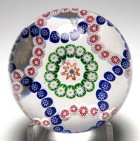 |
| 2992 | Baccarat 1971 Millefiori Mushroom Double
Overlay Paperweight. dated 1971. This
modern millefiori paperweight features a wonderful seven row
concentric millefiori design with design pulled down to the base
to form a slender stem, completing the mushroom form. The
two outer rings are somehow arranged to alternate when viewed from
the base resulting in a stunning spiral pattern. The design
is placed over clear crystal and finished with a red and white
double overlay. It is signed with a Baccarat complex "B1971"
signature / date cane in the outer ring. This paperweight is
also signed twice on the base with an acid etched Baccarat mark
along with the engraved year (1971) and edition number
(103). The red over white overlay is faceted with one large
top facet and six side facets. The base is cut with a
complex star pattern that is flat in the center. A fantastic
paperweight. A mushroom paperweight is one that contains an upright, mushroom shaped tuft of millefiori canes. Below the tuft at the top, the canes are pulled down to form a stem. Typically the top is either a closepacked design or a close concentric design. Sometimes, especially with antique paperweights, a torsade is added surrounding the stem of the mushroom. Millefiori mushroom paperweights like this are among the most difficult paperweights to make. Add the double overlay and you have an extremely challenging and desirable paperweight. Note on number of rows or rings: This design has either six or seven rows, depending on whether you count the very first ring around the single center cane. I have chosen to count the inner ring to be consistent with past listings. Note on limited editions: After extensive research in the Baccarat archives, Paul Dunlop concluded that popular designs like this were numbered editions, but not limited editions. Baccarat made them in more than one year as sales demanded and numbered the production sequentially. I am not entirely in agreement, but I am content to adopt Dunlop's terminology and refer to this as a numbered 1971 edition. I believe Baccarat intended to limit production of challenging designs like this double overlay mushroom. The records, if any, remain to be found. Baccarat was founded in 1776 in Alsace-Lorraine with the name of Verrerie de Sainte Anne. The original location was near the town of Baccarat. Today the firm is known as Compagnie des Cristalleries de Baccarat. In 1952, Paul Jokelson approached Baccarat with the idea of making sulphide paperweights again. In 1953 Baccarat resumed paperweight production with a series of sulphide paperweights the first of which were the unsuccessful Eisenhower sulphide followed by the Queen Elizabeth coronation sulphide. Millefiori paperweight production was resumed in 1957 and lampwork paperweights were re-introduced in the early 1970s. Baccarat stopped making this type of fine glass paperweights in 2002. You can read more about the Baccarat paperweights in his book Baccarat Paperweights - two centuries of beauty by Paul Dunlop or one of the older books on paperweights in general, such as The Encyclopedia of Glass Paperweights by Paul Hollister or World Paperweights by Robert Hall. Large size: 2 15/16" diameter by just under 2"
high. The base is cut
with a complex star pattern that is flat in the center.
The paperweight is faceted with one large top facet and a six side
facets. For extra pictures, click on the picture at the right and the following links: Large picture$495 postage paid in the US. Added 7/29/2023 For more information about Baccarat paperweights, see my Baccarat Paperweights Web Page Click on the picture to see a larger image. |
Click
on the picture to see a larger image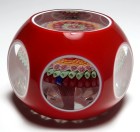 |
| 4856 | Baccarat 1976 Gridel Series Magnum
Millefiori White Monkey Limited Edition Paperweight. dated
1976. This modern millefiori paperweight features a large
central Gridel white monkey silhouette on a black background
surrounded by a ring of white canes. The white monkey cane is
set in the center of a paneled pattern with six panels of blue and
green millefiori and surrounded by a ring of identical green
canes. The panels are divided by rays of smaller Gridel canes
plus Baccarat's complex signature / date cane "B 1976". Each
ray contains three Gridel canes, with the exception of one ray which
contains two Gridel canes plus the signature / date cane. The
design is set on a translucent white ground. This design was
released in 1976 in a limited edition of 350 pieces. This is
number 186 in that edition. This paperweight is also signed on
the base with an acid etched Baccarat mark along with the year
(1976) and edition number (186). A fantastic
paperweight. In 1846 Baccarat introduced the popular Gridel figures in their closepack millefiori paperweights. It was named after Emil Gridel, the nephew of Jean-Baptiste Toussaint the general manager of Baccarat. Toussaint saw Gridel making paper cutouts of animals and saw an opportunity to incorporate these silhouettes in millefiori paperweights. From 1971 to 1979 Baccarat issued a modern Gridel series of millefiori paperweights based on eighteen Gridel figures. Each paperweight has a large Gridel figure in the center with smaller versions of the other figures included in the design. There are variations in orientation and color as well as the types of canes in each design and it is possible to amass a very large collection covering just this series. Very Large Size: Just under 3 7/16" diameter by
just under 2 5/16" high. The base is ground flat. For extra pictures, click on the picture at the right and the following links: Large picture$395 postage paid in the US. Click on the picture to see a larger image. |
Click
on the picture to see a larger image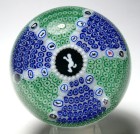 |
| 5892 | Baccarat Eleven Row 1971 Close Concentric
Millefiori Paperweight. dated 1971. This
magnificent close concentric millefiori paperweight has eleven rings
or rows with the outer ring pulled down to the center of the base to
form a stave basket. Baccarat made this design in 1971 and it
has an edition number of 357, but no edition size. The
paperweight is signed in the design with Baccarat's complex
signature cane "B 1971" in the next to the last ring. The
signature cane is upside down in the paperweight and can be
difficult to find. It also has an acid etched Baccarat mark
appearing twice on the base along with the year (1971) and edition
number (357). One of the best of the Baccarat concentric
paperweights. Large and showy with great color. Note on number of rows or rings: This design has either ten or eleven rows, depending on whether you count the very first ring around the single center cane. I have chosen to count it as a separate ring to be consistent with past listings. Either way, it is an impressive number of rings for a paperweight. Note on edition size: According to Paul Dunlop, this design is not a limited edition and the number made is unknown. Baccarat was founded in 1776 in Alsace-Lorraine with the name of Verrerie de Sainte Anne. The original location was near the town of Baccarat. Today the firm is known as Compagnie des Cristalleries de Baccarat. Most collectors refer to three periods of Baccarat paperweight production.
In 1952, Paul Jokelson approached Baccarat with the idea of making sulphide paperweights again. In 1953 Baccarat resumed paperweight production with a series of sulphide paperweights the first of which were the unsuccessful Eisenhower sulphide followed by the Queen Elizabeth coronation sulphide. Millefiori paperweight production was resumed in 1957 and lampwork paperweights were re-introduced in the early 1970s. Baccarat stopped making this type of fine glass paperweights in 2002. You can read more about the Baccarat paperweights in the book Baccarat Paperweights - two centuries of beauty by Paul Dunlop or one of the older books on paperweights in general, such as The Encyclopedia of Glass Paperweights by Paul Hollister or World Paperweights by Robert Hall. Large size: 3 1/16" diameter by 2 3/8" high.
The base is polished flat. For extra pictures, click on the picture at the right and the following links: Large pictureSOLD. Click on the picture to see a larger image. |
Click
on the picture to see a larger image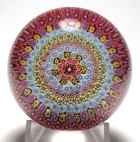 |
| 3539 | Baccarat 1974 Limited Edition Frog on a
Pond Paperweight. dated 1974. This modern
lampwork paperweight features a green frog with red stripes on a
transparent green pond. There is a nearby lily pad and some
rocks on the surface. It is signed with a Baccarat "B 1974"
complex signature / date cane in the design. This paperweight
is also signed on the base with two acid etched Baccarat marks along
with the engraved year (1974), edition number (163), and the edition
size (240). A fantastic design from Baccarat. Baccarat was founded in 1776 in Alsace-Lorraine with the name of Verrerie de Sainte Anne. The original location was near the town of Baccarat. Today the firm is known as Compagnie des Cristalleries de Baccarat. In 1952, Paul Jokelson approached Baccarat with the idea of making sulphide paperweights again. In 1953 Baccarat resumed paperweight production with a series of sulphide paperweights the first of which were the unsuccessful Eisenhower sulphide followed by the Queen Elizabeth coronation sulphide. Millefiori paperweight production was resumed in 1957 and lampwork paperweights were re-introduced in the early 1970s. Baccarat stopped making this type of fine glass paperweights in 2002. You can read more about the Baccarat paperweights in his book Baccarat Paperweights - two centuries of beauty by Paul Dunlop or one of the older books on paperweights in general, such as The Encyclopedia of Glass Paperweights by Paul Hollister or World Paperweights by Robert Hall. Large size: Just over 2 13/16" diameter by 1 15/16"
high. The base is polished concave. For extra pictures, click on the picture at the right and the following links: Large pictureSOLD. Click on the picture to see a larger image. |
Click
on the picture to see a larger image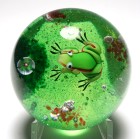 |
| 1377 | Baccarat 1988 Four Row Open Concentric
Millefiori Paperweight. dated 1988. This
paperweight has an open concentric design with four rows of colorful
millefiori around a central millefiori cane. The design is
placed over a clear ground. It is signed with an etched
Baccarat logo on the base. It also has a Baccarat "B1988"
signature / date cane in the outermost row. A fantastic
example of a modern open concentric from Baccarat. Baccarat was founded in 1776 in Alsace-Lorraine with the name of Verrerie de Sainte Anne. The original location was near the town of Baccarat. Today the firm is known as Compagnie des Cristalleries de Baccarat. Most collectors refer to three periods of Baccarat paperweight production.
Baccarat started making modern millefiori paperweights in 1957. According to Paul Dunlop ( Baccarat Paperweights: Two Centuries of Beauty ), Baccarat started making the modern spaced millefiori paperweights on muslin or lace in 1958 and continued making undated examples until the limited editions were started in 1970. The exception is 1964 when special versions were produced for Baccarat's 200th anniversary. Size: 2 11/16” diameter by 2 1/16” high. The
base is polished flat. For extra pictures, click on the picture at the right and the following links: Large picture$285 postage paid in the US. Click on the picture to see a larger image. |
Click
on the picture to see a larger image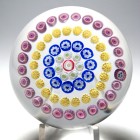 |
| 4850 | Magnum Baccarat 1975 Gridel Series
Pheasant Concentric Millefiori Limited Edition
Paperweight. dated 1975. This modern three
ring concentric millefiori paperweight features a large white
pheasant silhouette on a black background in the center. This
large center cane is surrounded by a circle of yellow millefiori
canes. The middle ring of canes has seventeen small Gridel
canes plus a Baccarat "B 1975" signature / date cane. The
pheasant Gridel appears only in the center, not in the middle
ring. The design is set on a transparent blue ground. In
addition to the Baccarat signature / date cane, this paperweight has
an acid etched Baccarat mark on the base along with the engraved
year (1975) and engraved edition number (46). This is a nice
balanced design. A beautiful addition to any collection of
Baccarat paperweights. This design was released in 1975 in a limited edition of 350 pieces. This is number 46 in that series. There is a signature / date cane "B 1975" shown in the pictures. The base has an acid etched Baccarat logo plus it is engraved with the year (1975) and the edition number (46). In 1846 Baccarat introduced the popular Gridel figures in their closepack millefiori paperweights. It was named after Emil Gridel, the nephew of Jean-Baptiste Toussaint the general manager of Baccarat. Toussaint saw Gridel making paper cutouts of animals and saw an opportunity to incorporate these silhouettes in millefiori paperweights. From 1971 to 1979 Baccarat issued a modern Gridel series of millefiori paperweights based on eighteen Gridel figures. Each paperweight has a large Gridel figure in the center with smaller versions of the other figures included in the design. There are variations in orientation and color as well as the types of canes in each design and it is possible to amass a very large collection covering just this series. Baccarat was founded in 1776 in Alsace-Lorraine with the name of Verrerie de Sainte Anne. The original location was near the town of Baccarat. Today the firm is known as Compagnie des Cristalleries de Baccarat. Most collectors refer to three periods of Baccarat paperweight production.
In 1952, Paul Jokelson approached Baccarat with the idea of making sulphide paperweights again. In 1953 Baccarat resumed paperweight production with a series of sulphide paperweights the first of which were the unsuccessful Eisenhower sulphide followed by the Queen Elizabeth coronation sulphide. Millefiori paperweight production was resumed in 1957 and lampwork paperweights were re-introduced in the early 1970s. Baccarat stopped making this type of fine glass paperweights in 2002. You can read more about the Baccarat paperweights in the new book Baccarat Paperweights - two centuries of beauty by Paul Dunlop or one of the older books on paperweights in general, such as The Encyclopedia of Glass Paperweights by Paul Hollister or World Paperweights by Robert Hall. Very large size: 3 3/16" diameter by 2 3/8"
high. The base is ground flat. For extra pictures, click on the picture at the right and the following links: Large picture$375 postage paid in the US. Click on the picture to see a larger image. |
Click
on the picture to see a larger image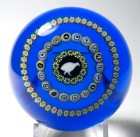 |
| 5558 | Large Antique Baccarat Dupont Period Type
III Pansy Paperweight with Star Cut Base. circa
1900-1920. Baccarat Pansy paperweight with leaves and
stem. The base is finished with a Baccarat star cut.
This paperweight is from Baccarat's Dupont period. This style
of pansy is called a type III pansy. It consists of two large
velvet purple petals above over three lower petals. The lower
petals are amber yellow over a white base. Each lower petal
has a purple tip and three dark lines radiating from the central
cane consisting of star canes with a red whorl center. A large
paperweight in great shape. Note: This paperweight has been restored in the past and has a relatively flat profile. There is plenty of glass and it could be reshaped to give it a proper profile. Note about provenance: The previous owner acquired this paperweight at the Selman Auction 37 (Fall 2006) Lot 41 and paid $460 including the bidders premium for the paperweight. Baccarat was founded in 1776 in Alsace-Lorraine with the name of Verrerie de Sainte Anne. The original location was near the town of Baccarat. Today the firm is known as Compagnie des Cristalleries de Baccarat. Most collectors refer to three periods of Baccarat paperweight production.
Large size: 3 1/8" diameter by 2" high. The
bottom is polished flat and finished with a Baccarat star cut
base. It has a relatively flat profile as shown in the
pictures. For extra pictures, click on the picture at the right and the following links: Large picture SOLD. Click on the picture to see a larger image. |
Click
on the picture to see a larger image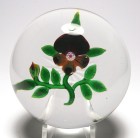 |
Revised 6/18/2024 ei9